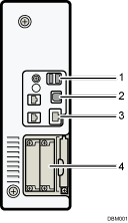This section explains how to identify the machine's interface and connect the machine according to the network environment.
![]()
|

USB Host Interface
Port for connecting a USB interface cable or USB interface device
Use this interface to connect the machine to a card authentication device, external keyboard, or Bluetooth.
USB 2.0 [Type B] port
Port for connecting a USB2.0 [Type B] interface cable
This interface allows the machine to print over USB connection.
Gigabit Ethernet port
Port for using a 1000BASE-T, 100BASE-TX, or 10BASE-T cable
Use this interface to connect the machine to a network.
If you use an Ethernet interface cable that supports 1000BASE-T, set [Ethernet Speed] to [Auto Select: Enable 1Gbps] in [Interface Settings] in [System Settings].
Slot B
Install the optional wireless LAN interface unit here.
The wireless LAN interface unit is required if you want to connect this machine to a wireless LAN. When installed in Slot B, this unit allows you to connect the machine to an IEEE 802.11 a/b/g/n wireless LAN.
![]()
The Gigabit Ethernet port and Wireless LAN interface unit cannot be used simultaneously. If the optional Wireless LAN interface unit is installed, you need to set [LAN Type] to [Wireless LAN] in [Interface Settings] in [System Settings].
The Bluetooth interface unit and the Wireless LAN interface unit cannot be used simultaneously.
